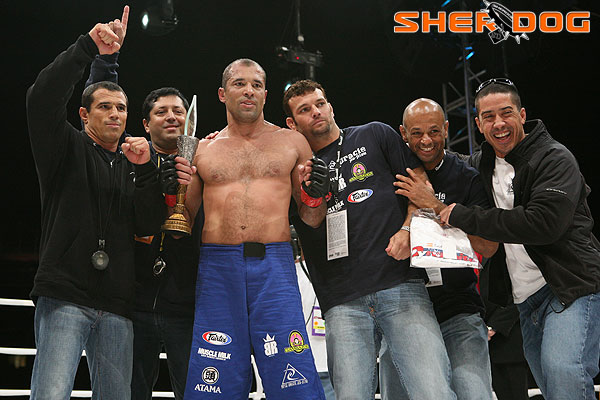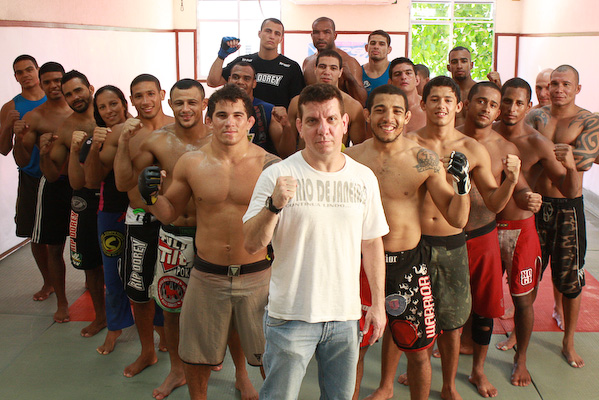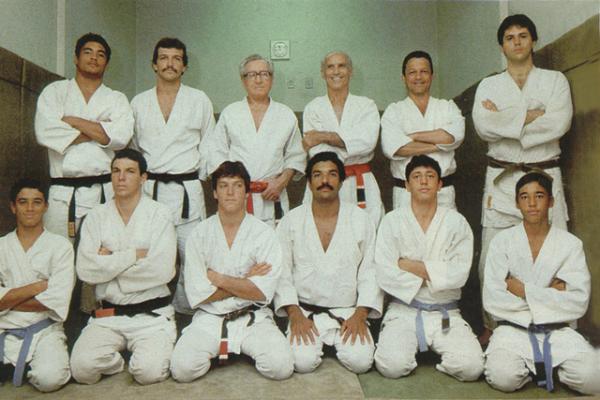Vale Tudo: A Rich, Storied & Complex Past
Allies and Rivals

Royce Gracie unwittingly helped spark the rivalry between
Brazilian jiu-jitsu and muay Thai. | Photo: Dave Mandel
It was 1982 in Teresopolis, a mountain city 75 miles outside Rio. Cousins Rilion, Renzo and Charles Gracie left a party in a car and headed to the 18-room house where the Gracies gathered on weekends. On the way, they spotted a girl on the roadside by herself and called out to her. What the Gracies had not realized was that Mario “Marinho” Dumar, a brother-in-law to and student of local muay Thai master Flavio Molina, was following close behind. Dumar did not appreciate the Gracies’ treatment of the girl, so he argued with Rilion. Dumar threw a punch and a scuffle broke out, but police showed up and the parties ran off before a resolution was reached.
In the 1980s, the martial arts world in Rio was tiny. Dumar lived in the same Flamengo neighborhood as Charles and was incensed when he heard that Gracie had told others he had “smashed a loudmouth in Terespolis.” A week later, Dumar ran into Charles on the streets of Flamengo. Charles happened to be with his then 15-year-old cousin, Royce. Dumar approached, cocked his arm and knocked out the teenager and future Ultimate Fighting Championship tournament winner with a punch to the nose.
Advertisement
The following week, Molina challenged Rolls to a fight in the local newspapers. A possible challenge between the two martial arts was under consideration when, on June 6, 1982, Rolls was tragically killed in a hang-gliding accident in Visconde de Maua. Considered by many family members as the best fighter in the Gracie clan, Rolls was 31 and left behind two sons, Rolles and Igor.
After Rolls’ death, Molina turned his sights to Rickson, who had
been picked by Helio as the new family ace. True to Gracie
tradition and form, Rickson said Molina would first have to deal
with his best student, brown belt Marcelo
Behring. If Molina defeated Behring, Gracie would then
challenge him. The proposed challenge gave Charles’ father, Robson,
an idea. At the time, Robson was an administrator for Maracana
Stadium and its smaller sister gym, Maracanazinho. Robson sensed it
was a perfect moment to raise the status of jiu-jitsu and his
family’s name, proposing a series of four challenge fights between
jiu-jitsu practitioners and other martial artists.
As kung fu movies were popular at the time, the Gracies arranged for a confederacy of Molina’s muay Thai fighters and other kung fu fighters. They even promoted Sergio Batarelli, a Sao Paulo-born kickboxing champion, as “Rocky Batarelli: the Italian Stallion,” to cash in on the early 1980s popularity of the “Rocky” films.
With Maracanazinho at his disposal, a super fight between Rei Zulu and the “Brazilian Rocky Balboa” planned and the allure of unbeatable Gracie jiu-jitsu fighters taking on other martial artists, Robson’s vision became a quick media sensation, attracting considerable press and sponsorship.
It was difficult for Molina to put together the team he wanted to face the Gracies. His two top students, Narany and Luiz Alves, refused to take part in the challenge. His only student who immediately accepted was Eugenio Tadeu, who felt he owed his trainer for allowing him to train for free. Molina was forced to look for recruits in luta livre circles. The luta livre fighters, who grappled without the gi, had long disapproved of the Gracie approach of invading academies and trying to humiliate athletes. Carlos Brunocilla’s top students, Marco Ruas and Marcelo Mendes, both accepted Molina’s invitation to join his team. This watershed moment forever knit together the muay Thai and luta livre communities.
Initially, the jiu-jitsu team was set with four Gracie Academy black belts: Behring, Fred Bomba, Inacio Aragao and Renan Pitanguy.
After his first grappling session with Brunocilla, Molina knew it would be best to postpone the event, but the Gracie side refused, certain that the fights would spill out into the street if they delayed the card. Making Molina’s situation worse, Mendes injured his knee days out from the event and had to be replaced by kung fu fighter Bruce Lucio. Meanwhile, the Gracie team actually grew stronger: an injury suffered by Bomba two weeks out led to his being replaced by Fernando Pinduka, who was regarded as Carlson’s top student at the time.
With the spate of injuries, only three jiu-jitsu against muay Thai and luta livre fights remained when the fighters squared off on Nov. 30, 1984. Zulu choked out Batarelli with a guillotine in the main event, while Aragao easily choked out kung fu fighter Lucio. However, the style war ended up in a draw; while Rickson student Behring easily mounted and beat Molina, young Tadeu surprised by knocking out Pitanguy. Ruas and Pinduka battled to a 20-minute draw, leaving the ledger at 1-1-1.
It was an iconic night, as it marked the first time the world of jiu-jitsu found worthy competition. It only fanned the flames of the growing rivalry, which would become the backbone of Brazilian vale tudo and MMA into the late 1990s. Even as the sport evolved past notions of “style,” the greatest Brazilian rivalries, such as Chute Boxe versus Brazilian Top Team, are still based on the idea of muay Thai against jiu-jitsu.
***

Photo:
M.Alonso/Sherdog.com
Andre Pederneiras has created a legion of
champions under the Nova Uniao banner.
Over two decades, dozens of fly-by-night promoters tried to change this, but most could only get a few events staged before shuttering their doors. Universal Vale Tudo Fighting, Pentagon Combat, Brazil Open, Super Challenge and Mo Team League all tried and failed.
Early on, Sergio Batarelli’s International Vale Tudo Championship was the one promotion that kept its flag planted, launching the careers of Wanderlei Silva, Jose Landi-Jons, Pedro Rizzo, Mark Kerr and Chuck Liddell. It was IVC that first put Curitiba’s Chute Boxe team on the map. After the IVC went by the wayside, Chute Boxe boss Rudimar Fedrigo and promoter Jorge Guimaraes put together Meca World Vale Tudo. Meca then filled the necessary role in the Brazilian fight scene, promoting the likes of Anderson Silva, Murilo Rua, Mauricio Rua and others to the world stage.
As the Japanese MMA scene cooled, so did Brazil’s local market for a brief time. Pride Fighting Championships fell under scandal, the Ultimate Fighting Championship became the world’s top promotion and it became necessary for Brazilian MMA promoters to adapt and create stable, reputable promotions that could prepare local fighters to face the world’s best in the cage. First, Ismail’s Jungle Fight answered the call. Jungle Fight put the spotlight on Lyoto Machida, Fabricio Werdum, Ronaldo Souza, Erick Silva and many of the fighters now considered to be the best in Brazil. Those who were not groomed by Jungle Fight likely rose through the ranks in Pederneiras’ Shooto Brazil, where Nova Uniao representatives such as Jose Aldo, Renan Barao and Eduardo Dantas learned their craft.
By showing that regional events could thrive in Brazil if they were well-promoted and offered a legitimate chance for fighters to advance their careers, Ismail and Pederneiras inspired the community. In recent years, events such as Watch Out Combat Show, Bitetti Combat, Max Fight, Nitrix Champion Fight and others have become staples in their local territories, helping to uncover the next generation of Brazilian talent.
Yet, with all of these shows and the UFC now planning several Brazilian events every year, the supply of Brazilian talent continues to outpace the demand. Thanks to its rich history in vale tudo, Brazil is now a continent-sized factory of champions where the next Aldo or Anderson Silva waits patiently for his turn.
« Previous Brazilian MMA Stars Gather for Launch of ‘From Vale Tudo to MMA, 100 Years of History’
Next Vale Tudo Relics: The MMA Debut of Dan Henderson »
More




 Marcelo Alonso’s MMA Roots Series
Marcelo Alonso’s MMA Roots Series



